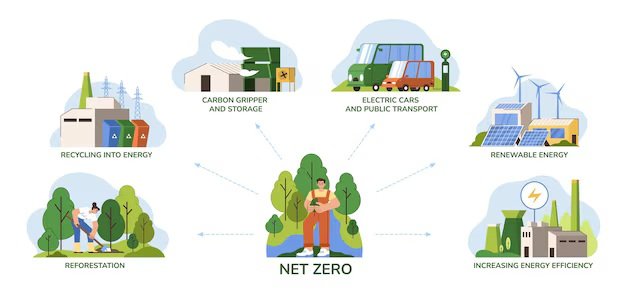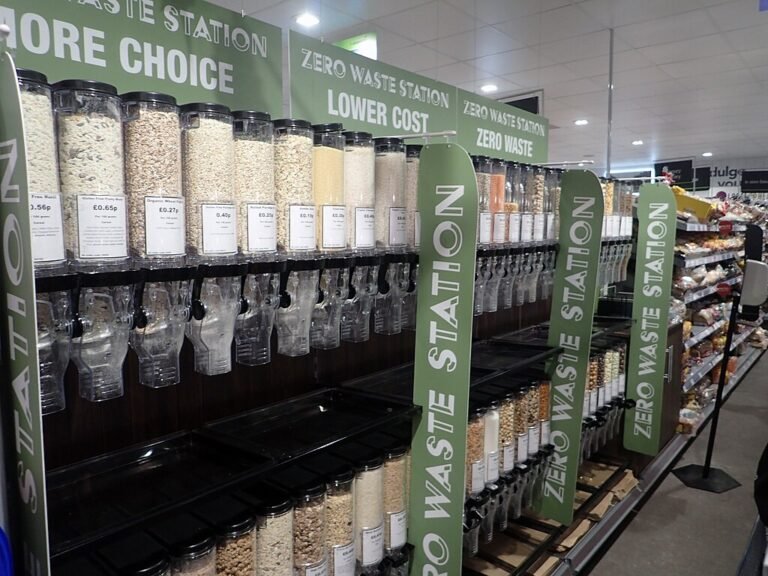10 Greenest Companies of 2025
In 2025, the conversation around climate change isn’t just about warnings and projections anymore—it’s about action. More than ever, companies are stepping up to prove that doing right by the planet isn’t just possible—it’s profitable, responsible, and necessary. Around the world, some of the biggest names in business, and a few surprising newcomers, are embedding sustainability into the very heart of what they do.
These companies aren’t just switching to LED bulbs or recycling paper in the breakroom. They’re rethinking their supply chains, investing in clean energy, designing eco-friendly products, and setting carbon neutrality goals that were once thought unachievable. And the impact is real—measurable reductions in emissions, waste, and water use, along with innovative programs that protect ecosystems and uplift communities.
This guide takes a closer look at the ten greenest companies of 2025. It’s about more than just rankings—it’s about understanding what real environmental leadership looks like today. You’ll see how bold choices, smart technologies, and a genuine commitment to sustainability are driving change across industries. Whether you’re a business leader, employee, or consumer, there’s something to learn—and be inspired by—in each of these stories.

In This Article
- 1. Schneider Electric (France)
- 2. Grupo Bimbo (Mexico)
- 3. Patagonia (USA)
- 4. IKEA (Sweden)
- 5. Samsung Electronics (South Korea)
- 6. Blackbaud (USA)
- 7. Nike (USA)
- 8. Switch, Ltd (USA)
- 9. Salesforce.com (USA)
- 10. Google LLC (USA)
- Key Takeaways and Actionable Insights
- Interactive Sustainability Metrics Table
- Conclusion
1. Schneider Electric (France)
When it comes to sustainability, Schneider Electric isn’t just talking the talk—they’re walking the walk. This French multinational has become a global leader in energy management and automation, proving that environmental responsibility and business success can go hand in hand.
In a bold move, Schneider Electric achieved carbon neutrality in its operations by 2025, five years ahead of its original target. But their commitment doesn’t stop there. They’re aiming for net-zero emissions across their entire value chain by 2050, aligning with the Science Based Targets initiative to limit global warming to 1.5°C.
At the heart of their strategy is EcoStruxure™, an open, IoT-enabled platform designed to enhance energy efficiency and sustainability across various sectors. From smart buildings to industrial automation, EcoStruxure™ provides real-time insights and control, enabling businesses to optimise energy use and reduce carbon footprints.
Their efforts haven’t gone unnoticed. Schneider Electric has received an “A” rating from the CDP for 12 consecutive years, reflecting its transparency and leadership in climate action.
But perhaps most impressive is the ripple effect of their initiatives. By helping customers save and avoid 800 million tons of CO₂ emissions by 2025, Schneider Electric is not only transforming its own operations but also empowering others to join the journey toward a more sustainable world.
2. Grupo Bimbo (Mexico)
When we think of fresh bread or a morning pastry, we often don’t consider the environmental impact behind its production. Yet, Grupo Bimbo, the world’s largest baking company, is reshaping that narrative by embedding sustainability into every facet of its operations.
In 2018, Grupo Bimbo made a bold commitment to power all its global operations with 100% renewable electricity by 2025, becoming the first Latin American company to join the RE100 initiative. Progress has been significant: by 2023, 92% of its electricity consumption was sourced from renewables like wind and solar.
The company’s renewable energy efforts are tangible. The Piedra Larga Wind Farm in Oaxaca, Mexico, supplies green power to nearly all of its facilities in the country, preventing approximately 180,000 tons of CO2 emissions annually. Additionally, the Bimbo Solar program has installed over 71 solar generation systems, including Mexico’s largest solar roof at its Metropolitan Distribution Centre.
Transportation, a significant contributor to carbon emissions, hasn’t been overlooked. By the end of 2023, Grupo Bimbo doubled its electric vehicle fleet in Mexico to over 2,500 units, making it the largest in Latin America. These vehicles, developed by its subsidiary Moldex, are powered entirely by renewable energy, aligning with the company’s goal to achieve net-zero carbon emissions by 2050.
3. Patagonia (USA)
When you think of outdoor gear, you might picture rugged jackets or sturdy backpacks. But for Patagonia, it’s about more than just apparel—it’s about purpose. Since 1996, they’ve committed to using only 100% organic cotton, a bold move that reduced their product line but significantly lessened environmental harm.
Their dedication didn’t stop there. Recognising the broader impact of agriculture on our planet, Patagonia co-founded the Regenerative Organic Alliance, promoting farming practices that restore soil health and combat climate change.
In their supply chain, Patagonia’s Environmental Responsibility Program ensures that manufacturing processes meet stringent environmental standards, from water use to greenhouse gas emissions. They’ve also embraced Fair Trade, with over 90% of their products made in Fair Trade Certified™ factories, directly benefiting more than 85,000 workers worldwide.
Even the materials they use are thoughtfully chosen. By sourcing Forest Stewardship Council-certified paper and natural rubber, Patagonia supports responsible forest management and biodiversity.
Patagonia’s approach demonstrates that businesses can prioritise the planet and people without compromising on quality or success. Their journey offers a model for how companies can integrate environmental and social responsibility into their core operations.
4. IKEA (Sweden)
When we think of IKEA, the first things that come to mind are stylish furniture, affordable prices, and those famous Swedish meatballs. But there’s more to the story. IKEA is on a mission to make our homes—and our planet—more sustainable.
By 2030, IKEA has pledged to use only renewable or recycled materials in all its products and packaging. This ambitious goal is part of their commitment to becoming a circular and climate-positive business. Already, over half of the materials they use are renewable, and nearly a fifth are recycled.
But IKEA’s efforts don’t stop at materials. They’ve invested more than €4.2 billion in renewable energy projects, including 49 wind farms and 26 solar parks across 17 countries. These initiatives generate enough clean energy to power over 1.47 million European homes annually.
In our own homes, IKEA offers practical solutions to help us live more sustainably. Their kitchen taps can reduce water consumption by up to 40%, and their bathroom taps by up to 50%, thanks to built-in aerators. They also provide energy-efficient LED lighting and appliances designed to minimise environmental impact.
5. Samsung Electronics (South Korea)
Since 2009, Samsung has recovered and recycled over 6.29 million metric tons of electronic waste across more than 60 countries. According to Statista, in 2023 alone, the company collected nearly 600,000 metric tons of e-waste, marking its highest annual collection to date. This achievement shows Samsung’s commitment to reducing the environmental impact of its products.
The “Samsung Recycling Direct” program, initially launched in the United States, has expanded its reach to Canada. In partnership with the Electronic Products Recycling Association (EPRA), Samsung Canada offers nationwide drop-off locations at Samsung Experience Stores, facilitating convenient and responsible recycling for consumers.
Samsung’s efforts have not gone unnoticed. The U.S. Environmental Protection Agency (EPA) has honoured the company with the Sustainable Excellence Award for ten consecutive years, recognising its leadership in e-waste collection and recycling.
Beyond recycling, Samsung is integrating sustainability into product design. The Galaxy S22 and S23 series feature packaging made from 100% recycled paper and protective films derived from recycled plastic. Additionally, the company’s Eco-Conscious Repair Program offers affordable repair options, reducing e-waste and conserving resources.
Samsung’s proactive approach to electronic waste management and recycling highlights the importance of corporate responsibility in the tech industry. By embedding sustainability into every facet of its operations, Samsung sets a benchmark for environmental stewardship.
6. Blackbaud (USA)
Recognised by Newsweek as one of America’s Greenest Companies for 2025, Blackbaud isn’t just about innovative software solutions; it’s about making a meaningful impact on our planet.
Since transitioning to a remote-first workforce in 2021, Blackbaud has achieved remarkable environmental milestones. The shift led to a 75% reduction in employee commuting emissions and a 63% decrease in energy emissions from office spaces. Their Charleston, SC headquarters, a LEED Gold-certified building, exemplifies sustainable design with solar panels and energy-efficient systems.
But Blackbaud’s commitment doesn’t stop at internal operations. The company collaborates with environmentally conscious suppliers, ensuring that sustainability is a shared value across its supply chain. This holistic approach underscores Blackbaud’s dedication to driving positive change beyond its immediate sphere.
Achieving 100% carbon neutrality for its 2023 emissions and a 92% reduction in global greenhouse gas emissions, Blackbaud sets a benchmark for the software industry. Their proactive strategies demonstrate that technological advancement and environmental responsibility can go hand in hand.
7. Nike (USA)
Through its “Move to Zero” initiative, Nike aims to achieve net-zero carbon emissions across its entire value chain by 2050. This ambitious goal includes a 65% reduction in emissions from owned or operated facilities and a 30% cut across its broader supply chain by 2030.
To reach these targets, Nike is reimagining its operations. The company has transitioned to 100% renewable electricity in its owned or operated facilities in North America and Europe. Innovations like Nike Forward, a material with a 75% lower carbon footprint compared to traditional fleece, exemplify Nike’s commitment to sustainable product design.
Water conservation is another critical focus. Nike has reduced freshwater usage in textile dyeing and finishing by 30% in some parts of its business. Collaborations with organisations like The Nature Conservancy aim to restore over 13 billion litres of water to stressed basins by 2025.
Nike’s holistic approach to sustainability—encompassing carbon reduction, renewable energy adoption, and water conservation—demonstrates the potential for large corporations to lead in environmental initiatives.
8. Switch, Ltd (USA)
As a technology and telecom firm, Switch isn’t just about data centres and connectivity; it’s about making a meaningful impact on our planet.
Switch has achieved a remarkable feat: powering all its operations with 100% renewable energy, amounting to nearly 984 million kilowatt-hours annually. This commitment isn’t just a statistic; it’s a testament to their dedication to sustainability. Since 2016, every Switch data centre has operated solely on renewable energy, showcasing its long-standing commitment to the environment.
Their efforts haven’t gone unnoticed. The U.S. Environmental Protection Agency recognised Switch as a Top 10 Green Power Leader, highlighting its significant contribution to advancing sustainable infrastructure. Moreover, a study by Compare the Market ranked Switch as the greenest company, emphasising their leadership in green power usage and net-zero emissions.
But Switch’s commitment goes beyond energy. They’ve adopted a net-positive water strategy, aiming to replenish more water than they consume, and have implemented innovative water conservation technologies in their operations.
9. Salesforce.com (USA)
Salesforce is showing us that the cloud can also be a powerful tool for environmental sustainability. In 2021, Salesforce achieved net-zero residual emissions across its entire value chain, encompassing scopes 1, 2, and 3 emissions. This milestone means that the company balances the greenhouse gases it emits with those it removes from the atmosphere, demonstrating a comprehensive approach to environmental responsibility.
Renewable energy is a cornerstone of Salesforce’s sustainability strategy. The company has committed to matching 100% of the electricity it uses with renewable energy. To support this goal, Salesforce announced plans to purchase 280,000 megawatt-hours of renewable energy certificates from small, distributed energy projects over eight years, accelerating clean electricity access in emerging markets.
Salesforce’s commitment to sustainability extends beyond its operations. The company offers Net Zero Cloud, a platform that enables organisations to track and reduce their carbon emissions. This tool helps businesses manage their environmental impact, aligning with global efforts to combat climate change.
In recognition of its efforts, Salesforce was ranked number two on Barron’s list of the 100 Most Sustainable Companies, highlighting its leadership in integrating sustainability into its business model.
10. Google LLC (USA)
When we think of Google, we often picture its search engine or Android phones. But behind the scenes, Google is making significant strides in environmental sustainability. In 2023, the company achieved a remarkable milestone by sourcing 105% of its electricity from renewable sources, totalling over 9.1 billion kilowatt-hours. This means Google not only powered its operations with clean energy but also contributed surplus green power to the grid.
Looking ahead, Google has set an ambitious goal: to achieve net-zero emissions across all its operations and value chain by 2030. This involves reducing 50% of its combined Scope 1, 2, and 3 emissions from a 2019 baseline and investing in both nature-based and technological carbon removal solutions to neutralize the remaining emissions.
To support this vision, Google is investing heavily in renewable energy infrastructure. In 2024, the company announced a $20 billion initiative to develop carbon-free power sources for its data centres, partnering with Intersect Power and TPG Rise Climate. Additionally, Google is exploring innovative energy solutions, including small modular nuclear reactors, to meet the growing energy demands of AI technologies.
Google’s commitment to sustainability extends beyond its own operations. The company aims to empower individuals, cities, and partners to collectively reduce 1 gigaton of carbon equivalent emissions annually by 2030 through its products and services.
Key Takeaways and Actionable Insights
- 1. Integrate Sustainability into Core Strategy: Companies like Schneider Electric and Nike demonstrate that embedding sustainability into the core business strategy leads to innovation and long-term success.
- 2. Invest in Renewable Energy: Organisations such as Grupo Bimbo and Switch, Ltd showcase the benefits of investing in renewable energy, both environmentally and economically.
- 3. Promote Circular Economy Practices: Patagonia and IKEA exemplify how adopting circular economy principles can reduce waste and create sustainable products.
- 4. Engage Stakeholders and Communities: Blackbaud and Samsung highlight the importance of involving stakeholders and communities in sustainability initiatives for broader impact.
- 5. Set Ambitious, Transparent Goals: Google and Salesforce.com illustrate the power of setting clear, ambitious sustainability goals and transparently reporting progress.
Interactive Sustainability Metrics Table
| Company | Renewable Energy Usage | Net-Zero Target | Industry |
|---|---|---|---|
| Schneider Electric | Achieved | 2025 | Energy Management |
| Grupo Bimbo | 100% by 2025 | 2025 | Food Production |
| Patagonia | 100% Organic Cotton | Ongoing | Outdoor Apparel |
| IKEA | 100% by 2030 | 2030 | Retail Furniture |
| Samsung Electronics | Extensive Recycling | Ongoing | Electronics |
| Blackbaud | Energy-Efficient Tech | Ongoing | Software |
| Nike | Renewable Energy | 2050 | Athletic Apparel |
| Switch, Ltd | 100% Achieved | Achieved | Tech & Telecom |
| Salesforce.com | 73% Usage | Achieved | Cloud Computing |
| Google LLC | 105% Usage | 2030 | Technology |
Learn More: When did Sustainability Become Popular in Business?
Conclusion
The greenest companies of 2025 exemplify how integrating sustainability into business operations is not only environmentally responsible but also economically advantageous. Their diverse approaches, from renewable energy investments to circular economy practices, offer valuable lessons for businesses and individuals aiming to make a positive environmental impact.
As consumers, investors, and stakeholders, supporting and learning from these sustainability leaders can drive collective progress toward a greener, more sustainable future.







